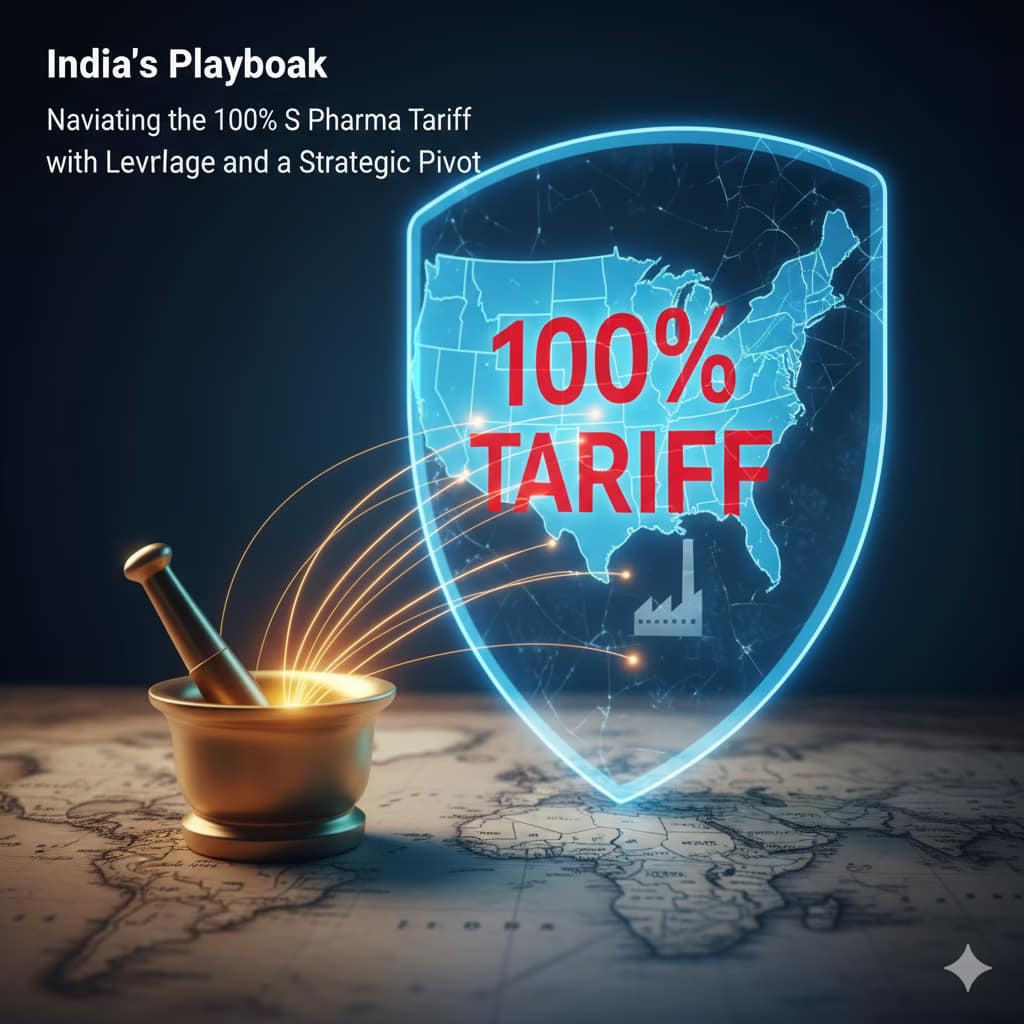President Trump’s 100% tariff on branded pharmaceutical imports, effective October 1, 2025, has created immediate market turbulence for Indian pharmaceutical stocks while revealing deeper strategic opportunities for the world’s largest generic drug supplier. As the “Pharmacy of the World” supplying 40% of America’s generic prescriptions, India faces a defining moment that could accelerate its transformation from a cost-efficient manufacturer to a global pharmaceutical powerhouse.
Market Impact Assessment
Protected Core, Vulnerable Margins
The immediate market reaction saw pharmaceutical stocks decline 2.6%, with major players like Sun Pharma dropping 3.4%. However, industry analysis reveals a more nuanced impact:
Generic Drug Shield: The bulk of India’s $10.5 billion pharmaceutical exports to America—comprising cheaper generic medicines—remains largely protected since tariffs explicitly target “branded or patented products”. This core business continues serving nearly half of US generic prescriptions without immediate disruption.
Specialty Segment Exposure: Companies focusing on complex generics, biologics, and branded specialty products face direct tariff impact. Sun Pharmaceuticals, Dr. Reddy’s, and other firms expanding into higher-margin specialty segments will experience immediate profit erosion until they establish qualifying US manufacturing operations.
Regulatory Uncertainty: The policy’s ambiguous language regarding “branded” and “patented” products creates uncertainty about whether complex generics and biosimilars might face future inclusion, generating ongoing investor anxiety despite current protection.
Existing Infrastructure Advantage
Built-in Tariff Protection
Many major Indian pharmaceutical companies possess significant protection through existing US operations that qualify for exemptions :
- Cipla, Dr. Reddy’s, and Lupin already operate FDA-approved manufacturing facilities within America
- Sun Pharma maintains operations across New Jersey, Philadelphia, Detroit, Wilmington, and Chicago
- Biocon and Aurobindo have established US manufacturing presence through acquisitions and direct investment
This existing infrastructure provides immediate exemption pathways for companies with established American footprints, reducing tariff exposure more than initial market reactions suggested.
Strategic Leverage Analysis
America’s Dependency Dilemma
India’s pharmaceutical industry correctly identifies its indispensable position in American healthcare economics. Indian generics save the US healthcare system hundreds of billions annually, creating genuine mutual dependence despite adversarial trade rhetoric. Key leverage factors include:
Volume Dominance: India supplies 47% of US pharmaceutical needs, representing scale that cannot be easily replaced. American domestic manufacturing capacity remains insufficient to substitute Indian production volumes without massive infrastructure investment requiring 3-5 years minimum.
Cost Structure Reality: Manufacturing pharmaceuticals in America costs 50-60% more than Indian production, making complete reshoring economically challenging without substantial government subsidies. This cost differential provides Indian companies with persistent competitive advantages even under tariff pressure.
Supply Chain Criticality: Any disruption to Indian pharmaceutical supplies would create severe drug shortages and price spikes in America, generating immediate political pressure for policy modification.
Adaptive Strategic Response
Accelerated Diversification
European Market Expansion: India is redirecting export focus toward European markets experiencing their own supply chain vulnerabilities, offering stable alternatives to unpredictable American trade policy. European pharmaceutical markets provide regulatory familiarity and growing demand for Indian generics.
Emerging Market Penetration: Latin American and African markets represent significant growth opportunities with less regulatory complexity and political risk than developed Western markets. These regions offer expanding middle-class populations requiring affordable pharmaceutical access.
Value Chain Advancement
Complex Generic Focus: The tariff pressure accelerates Indian companies’ transition toward sophisticated formulations and delivery mechanisms that command premium pricing while remaining technically “generic” products. This strategy allows higher margins while maintaining regulatory classification advantages.
Biosimilar Investment: Indian companies are expanding biologics capabilities, positioning for the massive biosimilar market as original biologic patents expire. This represents a natural evolution from traditional generics toward higher-value therapeutic categories.
API Independence: Reducing dependence on Chinese Active Pharmaceutical Ingredients through domestic production capabilities strengthens India’s supply chain autonomy while creating export opportunities to other pharmaceutical manufacturing nations.
US Manufacturing Strategy
Selective Investment: Rather than wholesale manufacturing relocation, Indian companies are strategically establishing US facilities for high-value products where American production costs can be absorbed while securing guaranteed market access through tariff exemptions.
Regulatory Timeline Navigation: Companies are accelerating “breaking ground” timelines to qualify for immediate exemptions while longer-term facilities undergo FDA approval processes. This creates bridge strategies maintaining market access during transition periods.
Regional Strategic Implications
South Asian Pharmaceutical Hub
This American pressure creates opportunities for India to strengthen its role as South Asia’s pharmaceutical supplier, potentially expanding medical diplomacy with Pakistan, Bangladesh, Sri Lanka, and Afghanistan. Reduced American market dependence could facilitate greater regional pharmaceutical integration.
Global Supply Chain Realignment
As Western nations seek to reduce Chinese pharmaceutical dependence, India emerges as the preferred alternative supplier offering democratic governance, English-language operations, and established regulatory compliance. This positioning strengthens India’s global pharmaceutical leadership.
Conclusion: Catalyst for Transformation
The pharmaceutical tariff policy represents less a roadblock than a powerful catalyst accelerating India’s pharmaceutical industry evolution. While creating immediate market volatility, the pressure forces strategic upgrades that position Indian companies for enhanced global competitiveness.
India’s response demonstrates sophisticated understanding of its leverage position—using cost efficiency and scale as negotiating tools while simultaneously diversifying markets and advancing up the value chain. The industry’s confidence reflects recognition that America needs India’s pharmaceutical supply more than India needs exclusive American market dependence.
The coming months will test whether this forced diversification and upgrading strategy successfully transforms tariff pressure into accelerated global pharmaceutical leadership, potentially making India’s industry more resilient and strategically valuable than before the policy implementation.

